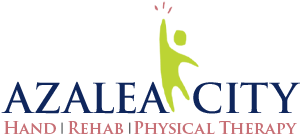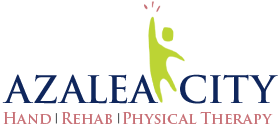Guide To Hip Replacement Physical Therapy/Occupational Therapy in Mobile AL

Hip replacement surgery can be life-changing, but recovery doesn't stop once you leave the operating room. Hip replacement physical therapy/occupational therapy in Mobile AL plays a pivotal role in ensuring a full, successful recovery. Why is it so important? Let Azalea City Hand and Rehab and Physical Therapy break it down for you.
- Restoring Mobility - After surgery, your hip needs to regain its range of motion and strength. Physical therapy/occupational therapy helps you gently work on those muscles, increasing flexibility and mobility over time. Without it, you might experience stiffness or reduced movement, which can slow your recovery.
- Strength Building - Your muscles around the hip joint may weaken during the recovery process. Physical therapists design custom exercise plans tailored to your body's needs, gradually rebuilding strength. These exercises target specific muscles that support the hip, reducing strain on the joint and improving stability.
- Preventing Long-Term Issues - Skipping or delaying physical therapy/occupational therapy can lead to complications, like scar tissue buildup or improper healing. This can result in chronic pain or limited range of motion, something you definitely want to avoid. The guided exercises from a professional therapist help prevent these issues, ensuring your hip heals properly.
- Pain Management - You might be surprised to learn that moving helps reduce pain after surgery. Controlled movements guided by a physical therapist promote blood flow, which accelerates healing and reduces inflammation. So while rest is essential, a balance of movement is key to pain relief.
- In short, physical therapy/occupational therapy isn't just about getting you back on your feet-it's about making sure you can move with ease and comfort for years to come. Skipping this crucial step could cost you long-term mobility and strength.
Physical Therapy/Occupational Therapy After a Hip Replacement In Mobile AL?
Timing is everything when it comes to physical therapy/occupational therapy after hip replacement surgery. So, when should you begin? Most patients are encouraged to start within 24-48 hours after surgery. Early movement is vital for a smooth recovery and helps prevent complications like blood clots.
Your first sessions will focus on gentle exercises, like walking with assistance or leg lifts while lying down. These activities increase blood flow, reduce swelling, and initiate the process of restoring movement. As you progress, your physical therapist will introduce more challenging exercises to build strength and flexibility. Starting physical therapy/occupational therapy early sets the foundation for long-term recovery and helps you get back to your daily routine faster.
Top Exercises to Regain Mobility After Hip Replacement Surgery In Mobile AL
Regaining mobility after hip replacement surgery takes time and effort, but the right exercises can make a huge difference. Below are some of the top exercises physical therapists recommend for a smooth recovery:
- Heel Slides - Start by lying on your back. Slowly slide one heel towards your buttocks, then extend your leg back to its starting position. This gentle movement helps improve knee and hip flexibility.
- Ankle Pumps - While lying down, point your toes away from your body, then flex them towards your body. This exercise is great for boosting blood circulation and preventing blood clots after surgery.
- Quadriceps Sets - Lie flat on your back with legs extended. Tighten the muscles in the front of your thigh, hold for a few seconds, and then release. This helps strengthen the muscles that support your hip joint.
- Standing Hip Abduction - Stand straight with support from a chair or railing. Slowly lift your leg out to the side, keeping your knee straight. This improves hip mobility and strengthens the muscles around the joint.
- Seated Marching - Sit on a sturdy chair with feet flat on the ground. Slowly lift one knee towards your chest, then lower it and repeat with the other leg. This simple exercise helps restore movement and strength in your hip muscles.
These exercises, when done regularly, can drastically improve your range of motion and reduce stiffness. Always consult your physical therapist before starting any exercise program to ensure it aligns with your recovery needs.
How Physical Therapy/Occupational Therapy Reduces Pain and Prevents Complications
Physical therapy/occupational therapy isn't just about regaining movement; it also plays a critical role in managing pain and preventing complications. By guiding you through controlled movements, a physical therapist ensures that you're using your body in ways that promote healing, reduce inflammation, and speed up recovery.
Moving your joint early after surgery helps prevent blood clots and reduces the risk of stiffness. Additionally, therapy sessions can prevent scar tissue from forming in ways that would restrict movement. The balance of activity and rest is key in reducing pain and ensuring long-term mobility.
Long-Term Benefits of Physical Therapy/Occupational Therapy Post-Hip Replacement
The benefits of physical therapy/occupational therapy extend far beyond the immediate recovery period. Regular sessions help improve flexibility, build muscle strength, and promote joint stability-all of which are essential for a healthy, active lifestyle. Physical therapy/occupational therapy reduces the risk of future injuries and can even help with issues related to arthritis or other degenerative conditions. By maintaining an ongoing therapy regimen, you set yourself up for a better quality of life in the long run.
Common Questions & Answers About Physical Therapy/Occupational Therapy And Hip Replacement
Q: When should I start physical therapy/occupational therapy after hip replacement surgery?
A: Most patients are advised to start within 24-48 hours after surgery. Early movement helps with circulation and sets the stage for a smooth recovery.
Q: How long will I need physical therapy/occupational therapy after my surgery?
A: Most people require 6-8 weeks of regular physical therapy/occupational therapy. However, the exact duration will depend on your progress and your doctor's recommendations.
Q: What exercises will I do in physical therapy/occupational therapy?
A: Your therapist will guide you through exercises like heel slides, ankle pumps, and leg lifts to improve mobility and strength.
Q: Can I do physical therapy/occupational therapy at home?
A: Yes! Many exercises can be done at home, but it's important to have a physical therapist guide you through the correct techniques to avoid injury.
Q: Will physical therapy/occupational therapy hurt?
A: You may feel discomfort, especially in the beginning, but physical therapy/occupational therapy is designed to help manage and eventually reduce pain as you heal.
Why Physical Therapy/Occupational Therapy Is Essential After Hip Replacement Surgery
Hip replacement surgery is a major procedure, but the real journey begins with recovery. Physical therapy/occupational therapy in Mobile AL plays an essential role in ensuring that you regain full mobility, strengthen the muscles around your new joint, and avoid complications like scar tissue buildup or long-term pain. Starting therapy within 48 hours post-surgery ensures the best possible outcomes, and continuing with exercises, under a therapist's guidance, can significantly improve your range of motion. Consistency in physical therapy/occupational therapy from Azalea City Hand and Rehab and Physical Therapy not only helps you recover but also ensures you stay active and pain-free for years to come.
OFFICE HOURS
Monday
8:00am - 5:00pm
Tuesday
8:00am - 5:00pm
Wednesday
8:00am - 5:00pm
Thursday
8:00am - 5:00pm
Friday
8:00am - 12:00pm
Saturday & Sunday
Closed
Azalea City Hand and Rehab and Physical Therapy
316 S Sage Ave Ste C
Mobile, AL 36606


